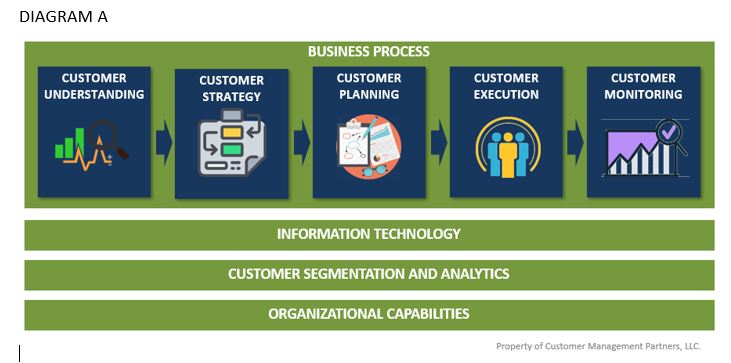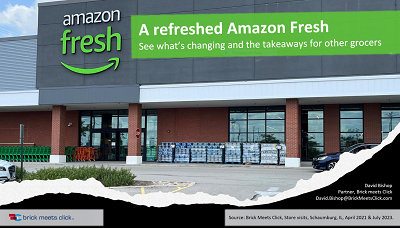Customer Management: Unlock new sources of profitable growth in grocery retail for 2020 & beyond
Complete the form below to instantly download this month's dashboard.

(6 min read) - Some of the big grocery players are changing the game by using Customer Management principles and their loyalty data to leverage more complete and competitive customer programs.Target's Circle is one example.
What may surprise you, is that Customer Management is within reach of most organizations (including your own). It should be a topic of strategic planning for both grocery retailers and manufacturers in 2020 because of its potential to unlock new sources of profitable growth.
Options - You can watch the video here or read the edited interview below
Here’s a topline summary.
- Customer Management gives retailers a way to define and execute different strategies for different groups of customers using a repeatable process which allows them to better target the needs of individual customers.
- Customer Management drives sustainable growth by helping to identify ineffective promotional spending that can be reinvested to deliver a greater return with the most valuable customers.
- The most successful organizations layer Customer Management on top of their existing Category Management framework so that customer insights are applied to the pricing,promotion and assortment decisions that are made for each item and store.
- Senior management typically believes that their organizations are aligned with the customer,while the people lower in the organizations are frequently unclear about how to do that.
- The biggest thing that’s keeping retailers from doing Customer Management is not having a clear process and strong support from the top management.
Copy below has been edited for length and clarity.
In this Q&A, Jim Dippold and Jean-Marc Sallenave, co-authors of the new book Customer Management: How Retailers Must Change to Survive and Succeed , sat down with us to explain what it is, how it improves business results, and the process and capabilities needed to capture those benefits.
BMC: What is customer management?
Jean-Marc Sallenave: Customer Management is a process for organizing and managing a retailer’s portfolio of customers as a strategic asset to achieve enhanced business results by attracting, keeping, and growing customers.
What it does is this: It gives retailers a way to define and execute different strategies for different groups of customers using a repeatable process that allows them to target the needs of their most profitable customers and grow that business.
How does it differ from what retailers are currently doing?
JMS: The biggest difference we’ve seen in our work is that the focus of the business changes. Instead of selling one category to as many customers as possible – the focus becomes selling to targeted customers as many categories and services as possible over their lifetime, using all the touch points at the retailer's disposal. It’s important to understand that customer management doesn’t do away with category management, it builds on it.
With customer management, personalization becomes more than just a way to deliver relevant product offers (as it's often used today). Instead, it becomes the foundation for a broader strategy to grow the customer’s value to the retailer.
"Organizing and managing a portfolio of customers" sounds very abstract. What does this mean?
JMS: It isn’t as complicated as it sounds. Organizing and managing a portfolio of customers begins with understanding customer differences – and any retailer with customer-identified purchase data can capture these differences. Organizing customers into groups according to how they behave allows the retailer to understand the composition of their customer base and where groups of customers fall across a variety of dimensions.
For example, take a customer called Emily – she:
- is relatively loyal to the retailer, which makes her a silver customer.
- falls in the deluxe segment, so she looks for quality in the food that she buys and favors premium products.
- has children, based on the products that she buys.
- responds to discounts, and her purchases have been stable over time.
Emily is the type of customer the retailer seeks to develop, because there's an opportunity to shift Emily – and customers like Emily – from silver to gold.
Jim, you’ve been working on Customer Management with retailers such as Safeway and Albertsons, Food Lion, and Delhaize. How does it improve business results?
Jim Dippold: We all know that these loyal and best customers dramatically affect the retailer's top and bottom line and that getting these customers to visit more often is what positively affects the top and bottom line. Once a retailer has the customer in the store, it's about getting them to buy larger baskets and to shop the store more broadly. This is what really differentiates successful retailers.
We've repeatedly seen Customer Management drive sustainable growth by helping to identify ineffective promotional spending that can be reinvested to deliver a greater return. It does this by embedding customer intelligence in day-to-day marketing and merchandising decisions that get more loyal, best customers to visit the store more often, have larger baskets, and shop the store more broadly.
What kind of business process is required to get the full value from Customer Management?
JD: It’s true that what gets measured is what gets planned, managed, and resourced. Today, most retailers view and manage their business primarily through the lens of products,so that’s what gets measured, planned, and managed through the structured activities of the Category Management process.
To grow your most valuable customers, you also need a process that allows you to measure, plan, manage,and resource. That’s why we developed the Customer Management process we discuss in our book.
- The Customer Management business process has five steps (see top row in Diagram A below): 1) customer understanding, 2) strategy, 3) planning, 4) execution, and 5) monitoring.
- To implement the process, three fundamental capabilities are needed – information technology,customer segmentation and analytics, and organization capabilities. These organizational capabilities include strong senior-level support and a clear understanding of what needs to happen.
Here’s how we’ve pictured it.

Do most retailers have the fundamental capabilities to make Customer Management work?
JMS: Most retailers have the first capability – the information technology needed to collect customer-identified purchase data.
For the second capability – customer segmentation metrics and analytics – it depends on the retailer. Some have more advanced capabilities, others not so much. Although most retailers have gaps in these areas, the good news is that these are generally available and increasingly affordable.
JD: The third fundamental– organizational capability – is the biggest thing that we see keeping retailers from implementing a successful, sustainable Customer Management process. Unless you have strong support from the top level, you're not going to be able to be customer-driven in the way we're discussing.
Why is senior-level support so critical to implementing Customer Management?
JMS : Making the shift to a customer culture that permeates the whole organization requires senior support because you are asking people to change how they’ve typically done their jobs. Currently, there’s a gap where there’s no one responsible for customer performance the same way you have people responsible for category performance.
The advocates for the customer in the current organizational structure often reside in the marketing teams, but the decisions about the shelf are made by the category management teams, and when it comes to retailer/supplier collaboration,conversations are still very product and category focused rather than focused on growing mutual best customers.
There’s a sort of wall between the two, such that decisions that are made by marketing, or the insights that are generated by marketing, do not always percolate through into the merchandising teams and are not reflected in the pricing, promotion, and assortment decisions that are actually made in the store.
How can a retailer assess their readiness to implement Customer Management?
JMS: Here is an example from a customer audit we did at a large U.S. retailer.

The statements in green are things that nearly everyone agreed on - having customer insights was important, we know our best customers, and they represent a significant growth opportunity among existing customers.
The statements in red show that the organization was not yet set up to drive that customer growth.There's a lack of training, customer intelligence is not used to make decisions,and there are no organizational incentives to drive customer performance.
Also telling is the fact that there isn't always widespread consensus around these questions even within the same retailer. The ratings can vary significantly depending on who you ask.
Lastly, it's typical for upper management to believe that the organization is aligned around the customer, when the people lower in the organization are unclear about their role in executing against that goal, and the processes and reward systems don't support customer performance.
Invitation: Moving towards Customer Management
Brick Meets Click and Customer Management Partners are offering a Customer Management Readiness Assessment.
- This analysis will explain how retailers are using customer data to run their businesses and assist in identifying opportunities for improving customer-centric retailing efforts.
- By participating in the analysis, you and your organization will gain access to the study findings and be able to request a free, personalized report showing how your customer-centric capabilities compare to your peers.
Related Posts
> How retailers & manufacturers work together in Customer Management to win the customer (blog)
Thanks to our contributors
Jim and Jean-Marc are the co-founders of Customer Management Partners, a consulting and professional services firm dedicated to helping retailers unlock profitable customer growth.
- Jim Dippold co-founded EYC and guided leading retailers in implementing shelf design,category management, inventory replenishment, and customer-centric retailing solutions while at Nielsen and IRI.
- Jean-Marc Sallenave has over 20 years of management consulting experience developing growth strategies and operational improvement plans for leading brands and retailers around the globe.












